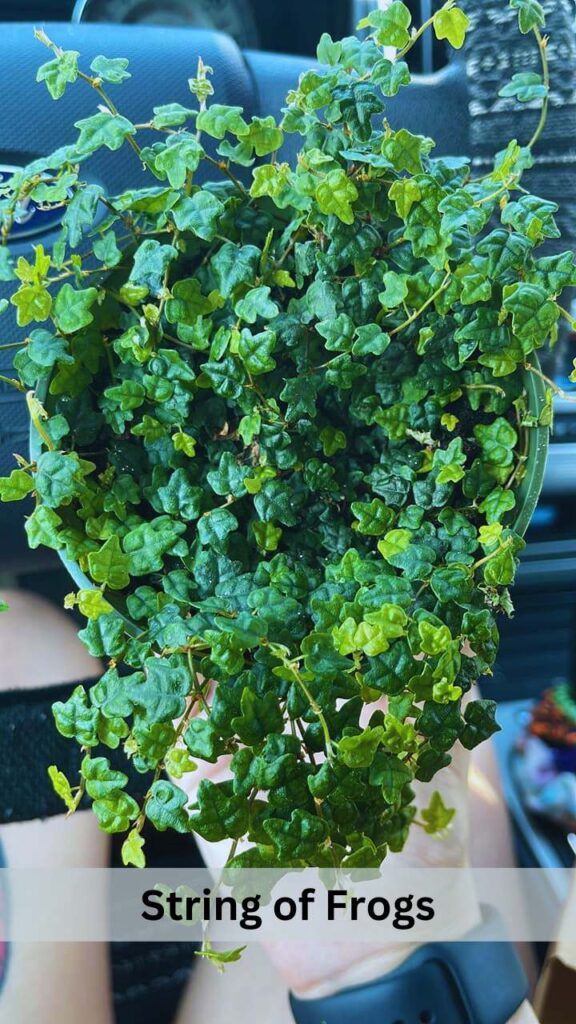Have you ever seen any creeping figs hanging around with tiny frog-shaped or oak-shaped leaves and wondered what that is? Well, it’s a string of Frogs. Here we present a complete guide for growing and caring for the string of frogs if you’re thinking about adding this beautiful houseplant to your collection.
Introduction
A string of Frogs is an evergreen, perennial creeping ficus species that got its name from its unique petite oak-shaped tiny leaves resembling the shape of squatting frogs. It is botanically called Ficus pumila ‘Quercifolia’. It is commonly called an Oak leaf creeping fig as its tiny lobed leaves look similar to oak leaves. The Quercifolia in its name comes from two Latin words, ‘Quercus’ meaning Oak and ‘folium’ meaning leaf. It is native to the tropical and subtropical parts of the East Asia region, like other Ficus species. It has shallow fibrous roots giving rise to trailing, multiple branching smooth, cylindrical brown stems forming a mat-like cover. The oak-shaped leaves extend about half inches and are light green with dark green veins. It is non-flowering and thus grown for its beautiful shiny foliage as a terrarium plant.

It is considered a rare houseplant, but in modern times its easy propagation, invasive nature, and availability in the market have made it a commonly seen houseplant. It is found in tropical and subtropical regions like others of the Moraceae family, mainly in USDA hardiness zones 9 to 11. It can be kept in small containers or pots and hanging baskets as well. So, you can use it indoors along with your other collections and outdoors in a space that can avoid direct sunlight. It is typically medium-growing, but the growth rate varies with the growing conditions provided to the plant. It takes about 2 to 3 years to mature and can survive decades if properly cared for. It can reach a height of 3m and can spread to 5m if left unpruned. The trailing stems are mostly spread out of the pot, and thus, the space should be wider compared to other houseplants in the same pot.
Right now, the most intriguing question in your mind may be, if I can grow it as a first-time plant owner? It is so, Yes, you can. It is a low-maintenance houseplant that you can grow easily, taking some of its care requirements into consideration. So, keep patience and read till the end to master your skill in growing the string of frogs as your first houseplant. A quick over-view of this plant is tabulated below:-
| Plant Name | String of Frogs |
| Other Name | Oak leaf creeping fig |
| Scientific Name | Ficus pumila ‘Quercifolia |
| Origin | Tropics and Sub tropics of East Asia |
| Growing Zone | USDA Hardiness Zones 9 to 11 |
| Grown For | Foliage Beauty |
| Plant Type | Tropical, Perennial and Evergreen Liana |
| Height | 3 M |
| Width | 5 M |
| Tolerance | Drought tolerant, Deer resistant, Salt tolerant |
| Toxicity | Toxic to Pets and Children |
| Price | $8 to $26 |
Botanical Classification
| Kingdom | Plantae |
| Clade | Tracheophytes |
| Clade | Angiosperms |
| Clade | Eudicots |
| Clade | Rosids |
| Order | Rosales |
| Family | Moraceae |
| Genus | Ficus |
| Species | pumila ‘Quercifolia’ |
USDA Growing Zone
This woody evergreen fig is found in USDA hardiness zones from 9 to 11, which cover extreme tropical regions like Hawaii and southern states of the USA like Texas, California, Florida, etc. The lowest temperature in this region ranges from -6 to 4 degrees Celsius. The daytime is warm, even in winter. So, the non-hardy plants are challenging to grow in these zones. Frost is rare, and the summer temperature may reach 40 degrees Celsius. The tropical, drought-tolerant plants thrive in these landscapes.
Special Features
What is special about this beautiful trailing plant is its uniquely oak-shaped or squatting frog-shaped leaves, which form an excellent ground cover and look great in a hanging basket. The low care requirement and its easy propagation method make it a better option.
Toxicity

This Ficus species is toxic to humans and pets, like dogs and cats. It is thus advisable to get thorough details about its possible impact on pets and children before going for it.
It produces milky latex from the detached part, which causes skin irritation and allergies. The white sap in contact with the skin may cause inflammation and may even lead to burns and blistering. So, it’s crucial to handle the plant carefully while detaching it and keeping it out of reach from pets and children. You should wear gloves or wash your hands thoroughly after doing the plant work.
It causes moderately toxic effects when ingested. The symptoms of ingestion include:
- Vomiting
- Diarrhea
- Skin inflammation
- Stomach Pain
- Decreased appetite
- Dermatitis
- Seizures
On the appearance of these symptoms or any suspicion, you should immediately seek medication advice in nearby hospitals or medicals.
Can String of Frogs Work In a Terrarium?
There can be no better choice for the terrarium plant than the string of frogs. Its unique leaves, trailing nature for ground cover, and hanging basket make it a perfect choice. This eccentric plant attracts every eye and also covers the gap space in the terrarium. Thus, it’s undoubtedly an excellent choice for a terrarium.
Variegated String of Frogs

The variegated string of frogs has a white achlorophyllous part, which makes the plant look beautiful. There is creamy variegation on the edges of each lobe or sometimes irregularly on the leaf surface. The variegation may be induced artificially for decoration or may appear naturally by mutation as well. This plant as variegated succulent looks stunning.
Care
Taking care of String of Frogs is not that complex and challenging. But there are a few things you should bear in mind to make the plant thrive well. You should protect it from direct daylight to avoid the overexposure effects like leaf spots, burning, etc. The soil must be well-draining, and water lodging should be avoided strictly. The watering should be when the top 2 inches of the soil becomes dry. Try to maintain the optimum temperature of 20 to 30 degree Celsius. When the temperature increases than the optimum, remember to increase the watering frequency. The high temperature drains out the energy of the plant. The plant enjoys a humid environment. You can use a humidifier or the pebble tray method and keep up with its humidity requirement. Fertilizing it monthly and repotting once in 2-3 yrs suits this plant. Training and pruning should be done according to the plant’s size and desirable shape.
Light
It prefers partially diffused light. Exposure to direct sunlight for a long time causes leaf scorching and necrosis. Outside, it prefers places under tree canopies with diffused light. While it is kept East or North facing the windowsill and under artificial growing light indoors. Remember not to make plants deficient in light. Under low light, the leaves become more extensive and distorted in shape. The plant thrives under the morning sun bath.
Temperature
The optimum temperature ranges from 20 to 30 degrees Celsius. Being a tropical plant, it can tolerate a minimum temperature of 10 degrees Celsius up to a maximum temperature of 35 degrees Celsius. It is good to maintain a cool, humid environment within the optimum temperature range.
Soil
Moving to its soil requirements, it prefers loamy or sandy loamy, friable, and well-drained soil with neutral pH. It has delicate roots. The non-draining soil medium may lead to water logging conditions which invite the problem of root rot and, eventually, the death of plants.
The soil mix can be prepared by adding perlites, pumice, sphagnum moss, little pebbles, organic matter, etc., which can make the soil more porous and increase its draining capacity.
Water
Since the plant is kept far from direct sunlight, the moisture loss is less than in other tropical plants. So, watering the plant once a week will do good. The watering frequency should be increased during extreme temperatures and then decreased to once in two weeks during winter. Remember, the soil should be moist but not wet.
You can prepare a watering schedule according to the temperature range in your area. The watering time can also be determined by dipping the finger into the soil. For this, dip your finger into a 2 cm soil dip. If the soil gets attached to your finger, watering is not required. If your fingers come out clean, you should know the soil is dry and it’s time to water your string of frogs. The watering should be done at the root level without putting pressure on the stem. Let the soil get dry in between the waterings.
Humidity
One of the traits of tropical plants is a cool, humid environment. A string of frogs also prefers humidity of about 60% to 80%. The leaves look glossy due to turgidity in the presence of high humidity. But it can survive in low humidity as well.
You can do misting or use a humidifier or use a pebble tray method to maintain the humidity level around the plant, especially in low-humid places.
Fertilizer
Fertilizing the plant is not a must factor if you have enough organic matter in your soil, but fertilizing it once a month ensures the proper growth of plants. You can use a dilute solution of liquid fertilizer every month, preferably in the summer and spring seasons when the growth is faster.
Potting and Repotting
Potting of this evergreen plant is done in the same way as other houseplants. First, choose a pot of size according to the space available in your place and to what extent you want the plant to grow. Earthen pots with a drainage hole can facilitate drainage as well. Keep some pebbles or small bricks and add the prepared, well-draining soil mix. The rooted plant is inserted, and the soil is kept moist under a shaded area.
The plant matures late, so the repotting can be done in about 2-3 years when the soil nutrients get exhausted. While repotting, a larger pot is chosen, and the new soil should be rich in nutrients.
Training and Pruning
You can prune the diseased or dead twigs anytime when you see them. Training can be done in a year or half year based on the desired size and shape. The plant grows faster after training and pruning.
String of Frogs Propagation
You can propagate this climbing fig through stem cuttings, leaf cuttings, and by seeds. Stem cutting is the most preferred method among them.
1. By seeds
It includes growing the plant directly from the seeds through germination. The moist, well-drained soil mix should be prepared first. The seeds should be inserted into the prepared soil mix, and the pot should be kept in a warm place with diffused sunlight until the rooting occurs in about 2-3 weeks. You can then transplant the rooted plants to the desired locations.
2. By leaf cuttings
You should first choose a healthy, well-lobed leaf to propagate through leaf cuttings. Cut the leaf, remove the petiole, and then the cut portion should be dipped in a rooting hormone. After dipping, plant the leaf cuttings into the well-drained potting mix. Water it lightly to make it moist, and keep it in the shaded area until the root sprouts in it, which take about 2-8 weeks. The rooted plants can then be transplanted into other pots and places.
3. By stem cuttings
Propagation by stem cutting is the easiest and most reliable method of propagating a string of frogs. You can follow the given steps for it:
- Choose a healthy stem with 2-3 nodes and trim it below the node. Stems with roots increase the chance of cutting.
- Prepare a moist, well-draining substrate with the sphagnum moss topped on it.
- You can dip the cutting in the rooting hormone and place it into the medium with the node to be rooted inside the medium.
- Moisten it and keep the pot in a humid environment and diffuse sunlight or grow light until the rooting starts.
- You can then transplant the rooted cuttings in about 2-6 weeks and grow them under normal conditions.
Price
The price of the potted plant varies with the number of leaves, pot size, shipping distance, etc. Typically, the price ranges from $8 to $26. You can buy it online from different online shopping sites like Amazon and Walmart and the websites of the shops themselves.
Common Problems
The significant problems with a string of frogs may be sun scorching, leaf spots, yellowing, browning, root rot, wilting, and pest attacks. The plant is susceptible to pests like Spider mites, Mealybugs, Scales, and aphids as well.
The physiological problems can be solved by maintaining proper growing conditions. And the pest attacks can be prevented by spraying pesticides or horticultural oil or using cotton balls and swabs dipped in alcohol, or mechanically removing the visible insects.
Pros and Cons
| Pros | Cons |
| String of Frogs has beautiful and exemplary-shaped leaves. | The harmful or risky factor for this plant is its sap toxicity |
| It can be used as a cover plant or in a hanging basket. | The contact with its sap causes skin problems, and the ingestion invites poison-like symptoms. |
| It is easy to care for and protect. | The plant is sensitive to direct sunlight and a dry environment. |
| It can be grown in small space also. | The appearance of irregular physiological disorders may be an obstacle in your way. |
Final Words
Having a string of frogs as your houseplant will get the visitor’s eyes struck by it. Who won’t love those beautiful squatting frog-like leaves trailing through the hanging basket? You can give it a go even as a beginner, and the satisfaction you get from seeing every leaf grow will undoubtedly prove your hard work worthy and fruitful. So, why not give it a try?
FAQs
Is Ficus quercifolia a String of Frogs?
Yes, Ficus quercifolia is also called String of Frogs, along with other names like oak leaf ficus, oak leaf fig, etc. The Quercifolia itself comes from two Latin words; Quercus meaning oak, and folium meaning leaf. So, the Ficus species with oak-shaped or lobed squatting frog-shaped leaves are known by the botanical name Ficus pumila quercifolia and commonly as String of frogs.
Is String of Frogs Good For First-Time Plant Owners?
As a first-time plant owner, you may have to work a little more on maintaining the proper environmental conditions, but once it is done, you can grow this climber as your houseplant without much effort. You can restfully include a String of frogs in your houseplant collections.


